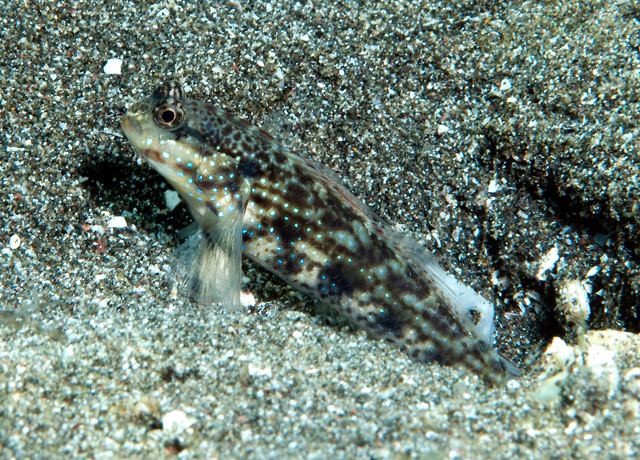| Gobiidae (Gobies), subfamily: Gobiinae |
| 7.5 cm SL (male/unsexed) |
|
reef-associated; brackish; marine; depth range 0 - 3 m |
| Indo-Pacific: Red Sea to western New Guinea, north to the Yaeyamas in the southern Ryukyus; Palau in Micronesia. |
|
Dorsal spines (total): 7-7; Dorsal soft rays (total): 10-10; Anal spines: 1-1; Anal soft rays: 10-10. Large spine at lower posterior edge of preoperculum; characterized further by pale grey body color with narrow brown stripes and longitudinal rows of small white dots on side of body; lower side of body with row of five large rectangular brown blotches; irregular brown saddles along back; large grey spot above base of pectoral fin; elongate and filamentous fourth dorsal spine; rounded caudal fin; longitudinal scale series 23-25; head and nape without scales; ctenoid body scales except cycloid on abdomen, base of pectoral fin and prepelvic region; median predorsal scales absent; opening of gill not reaching to above edge of preopercle; moderately long cheek spine, 21-27% head length, not reaching posterior margin of opercular membrane; depth of body 4.8-5.4 in SL (Ref. 90102). |
| Inhabits tide pools of sandy intertidal areas of lagoons, bays, and river mouths. Also lives in sheltered sandy bays and estuaries among rubble and in lagoons along edges of coral patches. Usually found in small loose groups (Ref. 48637). |
|
Least Concern (LC); Date assessed: 26 June 2018 Ref. (130435)
|
| harmless |
Source and more info: www.fishbase.org. For personal, classroom, and other internal use only. Not for publication.

